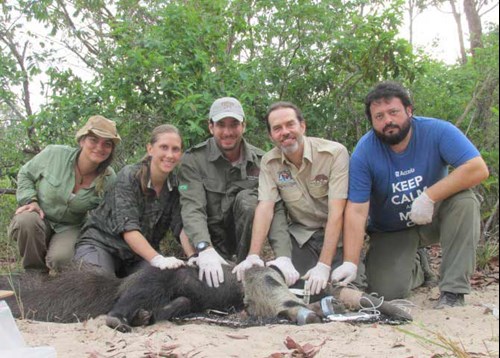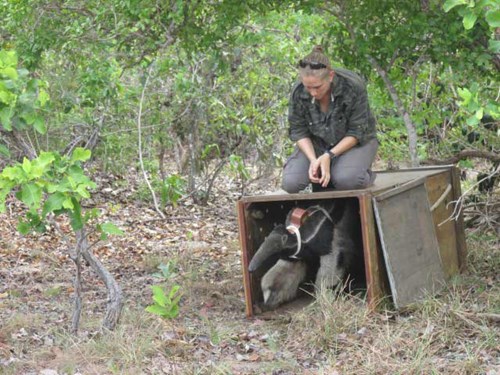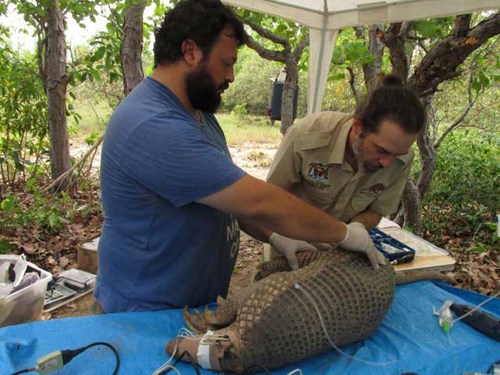Arnaud's Blog: Update from the Pantanal and Cerrado
28/12/2015 in Conservation

Giant Armadillo Project team with Yamil.
It seems incredible that 2015 is almost over. This year really flew by so fast. I want to give an update on our activities for the past two months, where we ran two expeditions in the Pantanal and several shorter expeditions in the Cerrado. We are really delighted with the progress we have made during all expeditions and the past two months have been very productive.
The end of October/early November expedition consisted of myself, Camila Luba and Yamil di Blanco, an Argentinian researcher. Yamil has been working for the past six years on a giant anteater reintroduction project in Ibera, Argentina. He was responsible for monitoring giant anteaters that were released as part of a reintroduction programme. Animals came from captivity, private individuals or rescues. He recently completed his PhD analysing habitat use and home ranges of these animals. Yamil had been advising us remotely on several aspects of our giant anteater work and it was fantastic to welcome him in the field. Most importantly, Yamil will be using some of the giant anteater data we collected to compare results with his work in Ibera. Are the reintroduced giant anteaters behaving similarly to wild giant anteaters? Ibera is also a wetland and the structure of the landscape is very similar to the Pantanal. This comparative study will be very important in assessing the success of the reintroduction. We are very happy about this Argentinan-Brazilian cooperation.

Camila releasing an anteater fitted with a transmitter.
One of the main focuses of this expedition was recapturing our giant anteaters and testing the new giant anteater harnesses. You may remember that we recently discovered that the giant anteater harnesses we put on animals in June and July where not functioning properly. The manufacturer replaced all the harnesses free of charge, but that of course means recapturing the animals. Gabriel Massocato and Bruna Oliveira came for a few days during this expedition to help us with this work. The new harnesses now use a different technology and can send some data every four days directly to my e-mail. We decided to test these new harnesses on three animals before rolling them out more widely. We were very happy that in just three days we managed to recapture three animals, one each day, and fit them with new harnesses. Harnesses were also removed from other animals. I am happy to report that in December all three animals are doing well and data seems to be efficiently collected. Fingers crossed!
For the past few months during every expedition the big question is always: are our three adult females pregnant? In November we raced to answer this question. We struggled but were surprised to find Isabelle. Her transmitter batteries are due to run out. She was not exhibiting any nesting behaviour and continued her routine of changing burrows. Another female, Jessica, was also rapidly located as she has a GPS device which emits a signal we can locate at greater distances. No baby for her either. As for Mariana, despite searching for her for several days we were unable to locate her. Roberta, on the other hand, is a sub-adult we estimate to be almost three years old and still immature. Roberta was successfully recaptured and we managed to fit a GPS device onto her.

Arnaud and Yamil with giant armadillo Roberta.
Roberta´s recapture took three nights as we had problems with a rat gnawing through the thread that keeps the trap door open. This meant racing through the night excited to see a giant armadillo and getting frustrated when all that came out was a rat! Once captured, the procedure went smoothly and Roberta was released with a GPS device. We did not, however, see any signs of her mother Dolores, who we have not seen for several months now.
During the expedition we also planned to capture Wally. With Camila being part of the expedition we wanted to collect another semen sample from him (the last chance we’d get before his transmitter batteries ran out). It took us several days to locate him. Finally, on almost on the last day and deep into the afternoon, we picked up a faint beep. We were overjoyed. Unfortunately, however, Wally was located deep in forested area that was very difficult to reach, so there was no way we could set our trap. We decided to attempt to catch him by hand. That evening as we prepared to get out a major storm broke! We need to use our telemetry device to locate the animal and it cannot get wet. We had to cancel our plans. Unfortunately the next day we were not able to locate him and our time in the field ran out. Frustrating, but all part of life in the field as part of the Giant Armadillo Conservation Project!
Until next time!
Arnaud
Regional Coordinator (Latin America), RZSS Research and Conservation
Featured Content
Featured Articles

An update from the Budongo Forest
19/04/2024 in Conservation

Edinburgh Zoo named best zoo in Scotland
15/04/2024 in Edinburgh Zoo

























Follow EZ